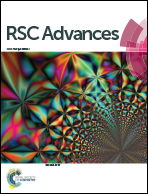Introducing a composite coating containing CNTs with good corrosion properties: characterization and simulation
Abstract
A duplex composite coating containing carbon nanotubes (CNTs) was successfully deposited on a Mg–Zn–Ca alloy by an atmospheric plasma spraying (APS) technique. The NiCoCrAlYTa coating, as the first layer included a large number of voids, globular porosities, and micro-cracks with a thickness of 90–100 μm, while the nanostructure TiO2 (nTiO2) coating, as the second layer, presented a unique bimodal microstructure with a thickness of 140–150 μm. The incorporation of CNTs into TiO2 led to the reduction of surface defects as a result of the filling of porosities and pinholes of the surface by the CNTs. The corrosion current density (icorr) of an uncoated sample was about 208.2 μA cm−2 which decreased to 67.2 μA cm−2 after applying the second layer. In the most optimal mode, it was found that the icorr decreased significantly to 17.3 μA cm−2 after addition of CNTs to nTiO2 coatings. At the end, by the use of gene expression programming (GEP) for the first time, the corrosion rate of the nTiO2 coating containing CNTs was simulated and formulated. The results presented by the GEP software were compared to the experimental ones and the GEP based formulation for predicting corrosion rate, was evaluated. The results showed a negligible error of 0.5 mm per year in predicting the corrosion rate, which confirms a high accuracy simulation of the corrosion behavior of the composite coatings containing CNTs.


 Please wait while we load your content...
Please wait while we load your content...